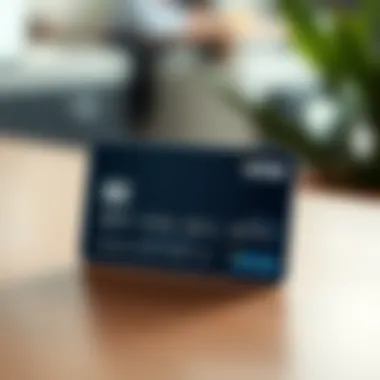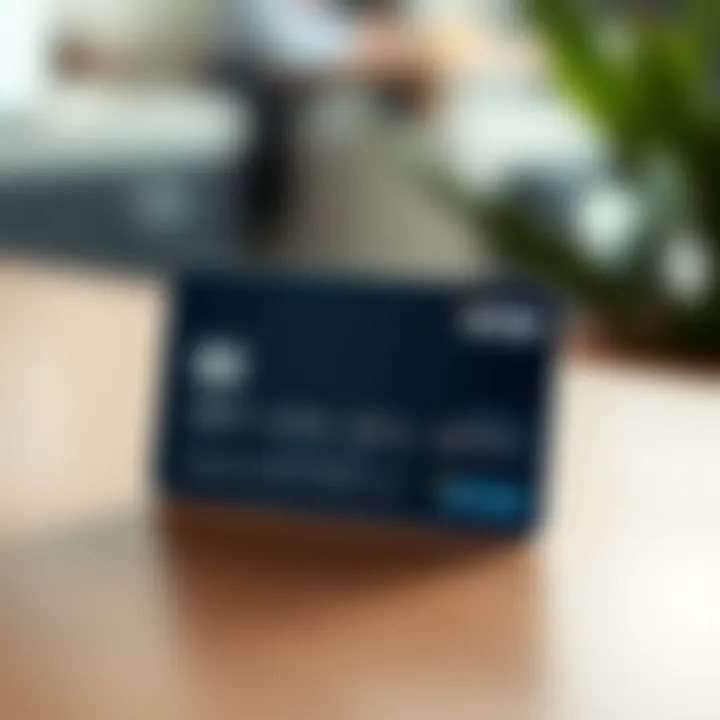Understanding Visa Cards with Funds: A Comprehensive Guide


Intro
Visa cards preloaded with funds offer a unique blend of convenience and security, making them increasingly popular among consumers. These cards act as a bridge between cash and credit, allowing users to transact with ease while also managing budgets effectively. Understanding these financial tools becomes essential, especially as our reliance on digital payment methods continues to grow. In this comprehensive guide, we will dissect the operational mechanics, the various types available, and the key benefits and challenges associated with these cards, equipping you with the knowledge needed to navigate this financial landscape.
Investment Terminology Breakdown
Key Terms Explained
When it comes to Visa cards preloaded with funds, it helps to familiarize oneself with some key terminology:
- Prepaid Card: This is a type of card you load with a specific amount of money. Unlike traditional credit or debit cards, you can only spend what is loaded.
- Reloadable Card: This prepaid card allows for additional funds to be added after the initial load. A feature that many users find beneficial.
- Transaction Limits: These denote the maximum amount you can spend or withdraw within a specified time frame, often designed to curb unnecessary expenditures.
Familiarizing yourself with these terms can enhance your understanding and usage of such financial instruments.
Common Misconceptions in Investing
Many individuals harbor misconceptions surrounding prepaid Visa cards. Here are a few:
- Aren't Just for Kids: Often viewed as a tool only for children or teens, these cards can be utilized by anyone seeking to manage their finances more effectively.
- Lack of Security: Some think prepaid cards are inherently less secure than their credit or debit counterparts. However, many offer fraud protection and monitoring services that enhance security.
- Only for Travel: While these cards are excellent for travelers wishing to budget spending while abroad, their application spans daily transactions to online purchases.
Financial Product Reviews
In-Depth Product Analysis
When selecting a Visa card preloaded with funds, it's vital to consider several offerings on the market. Here are a few notable ones:
- Chase Liquid Card
- NetSpend Prepaid Card
- PayPal Prepaid Mastercard
- Known for no monthly fees, it offers easy access to funds and the ability to reload at various locations.
- This card provides robust features such as online account management and the option to earn interest on deposits.
- Aligned closely with PayPal accounts, it allows seamless transitions for online purchases or payments anywhere Mastercard is accepted.
Pros and Cons of Each Offering
Chase Liquid Card
- Pros: No monthly fees, wide acceptance
- Cons: Limited withdrawal options
NetSpend Prepaid Card
- Pros: Automatic savings feature, online account management
- Cons: Monthly fee after the first 30 days
PayPal Prepaid Mastercard
- Pros: Easy access to PayPal funds, extensive usability
- Cons: Fees for ATM withdrawals can add up
Choosing the right financial product depends not only on its features but also on how well it aligns with your personal financial habits and goals.
Prologue to Visa Cards with Funds
Visa cards with funds are gaining traction in today’s financial landscape. They cater to a diverse array of users, from individuals who prefer fixed spending to those who seek to manage their finances more effectively. Understanding these cards is critical because they offer a different kind of flexibility compared to traditional banking methods, helping users navigate their financial paths with confidence.
Definition and Purpose
Visa cards with funds are essentially financial tools that allow users to make purchases, transfer money, or even pay bills using preloaded money. Unlike traditional debit or credit cards which draw from an existing bank account or a credit line, these cards operate on the principle of pre-payment. Users can load a set amount onto the card, which then becomes available for expenditure, minimizing the risk of overspending.
The purpose of these cards is multifaceted. First and foremost, they provide a straightforward method for budget management. With a set limit, it’s easier to control how much is spent in a given period. Moreover, they serve as an excellent option for those who may not qualify for traditional credit cards due to credit history issues. Additionally, they often come with lower or no associated fees, enhancing their appeal for casual users or those cautious about financial commitments.
Contrast with Traditional Debit and Credit Cards
When we compare Visa cards with funds to traditional debit and credit cards, several key differences emerge. Traditional debit cards are linked directly to a bank account. This means that users can spend only what they have in their accounts, which, while helpful for some, may lead to fees for overdrafts or unwanted denial of transactions when funds run low. On the other hand, with a Visa card preloaded with funds, users know upfront how much they can spend. It's akin to managing your wallet but in a more secure and accessible form.
Credit cards operate on a different paradigm entirely, allowing users to borrow against a line of credit, ideally with rewards, but also posing risks of debt accumulation with high interest rates. In contrast, Visa cards with funds eliminate this risk. They encourage responsible spending, as you cannot spend beyond what you've loaded onto the card. However, it’s noteworthy that they usually don't help build credit, which can be a downside for users looking to improve their credit scores.
"A Visa card with funds might be the ideal solution for budgeting: it promotes discipline while still offering convenience."
Types of Visa Cards with Funds
When navigating the vast array of financial tools available to consumers, Visa cards with funds have carved a distinct niche. Understanding the different types is crucial, as each serves unique purposes, catering to various needs and preferences. These types come with unique advantages, drawbacks, and practical considerations, which are essential to comprehend when selecting the right card.
Prepaid Visa Cards
Prepaid Visa cards are like debit cards but without the link to a traditional bank account. Users load a specified amount of money onto the card prior to spending. This provides a clear advantage in budgeting—once the funds are expended, no more spending can occur unless additional funds are loaded. This not only helps in managing expenses but also reduces the risk of incurring debt, a feature attractive for those mindful of their financial limits.
Another benefit of prepaid Visa cards is their widespread acceptance at merchants that accept Visa. This allows for easier purchases both online and in physical stores. Furthermore, they can often be obtained without a credit check, making them accessible to a wider audience who may not qualify for a standard credit or debit account. However, keep an eye on fees associated with activation and reloading, which can vary widely between providers.
Gift Cards
Gift cards have gained popularity as a thoughtful, convenient gift. These cards function much like prepaid cards but are generally limited to specific retailers or chains. The ease of gifting is clear—purchasing a gift card means you’re giving the recipient the freedom to choose their own present. It’s a way to show appreciation without the burden of selecting a potentially unwanted item.


However, the limitations on where the card can be used might not sit well with some. Expiration dates and potential inactivity fees can also be hurdles. It’s vital for recipients to pay attention to these details to maximize the card's value. Furthermore, many people are unaware of the balance left on their gift card, which can lead to unspent funds. Staying on top of this can help ensure that the gift truly serves its purpose without leaving money on the table.
Travel Cards
Travel cards are specifically designed for individuals who often find themselves in different countries or regions. They allow users to load multiple currencies, letting travelers avoid exorbitant foreign transaction fees from regular credit cards. Imagine wandering through the bustling streets of Rome without constantly calculating currency exchanges in your head—this convenience makes travel cards particularly appealing.
Many of these cards also come with additional perks such as travel insurance, purchase protection, or enhanced security features. However, as they’re chiefly for international travel, it's crucial to verify if they are applicable or beneficial in your home country, as some may impose restrictions on where they can be used or incur additional charges.
Reloadable Cards
Reloadable cards offer remarkable flexibility, functioning similarly to prepaid cards but with the additional capability of adding funds as needed. Users can top up the balance from a bank account or through direct deposit features. This allows for ongoing use without needing to acquire a new card each time the balance runs low.
Moreover, reloadable cards often provide online account management tools, making it simpler to track spending and reload funds. They can be beneficial for people who prefer cashless transactions. However, these cards can sometimes come with hidden fees for reloading or using out-of-network ATMs, which can catch users off guard. Understanding these fees is key to ensuring that the card remains a beneficial tool rather than a costly convenience.
To sum it up, each type of Visa card with funds presents distinct advantages and limitations. Choosing wisely based on individual needs and lifestyle can lead to fulfilling financial management, rather than a burdensome payment method.
Benefits of Using Visa Cards with Money
When it comes to managing your finances, Visa cards preloaded with funds can be game-changers. They’re not just a convenient way to make purchases; they also provide an array of benefits that help users maintain financial control. This section will delve into the nuances of those advantages, highlighting why they are becoming increasingly popular among consumers and professionals alike.
Control Over Spending
One of the most significant benefits that comes with using Visa cards loaded with funds is the control over spending they provide. Unlike traditional credit cards that can lead users into a debt spiral, prepaid Visa cards enforce a natural limit since they only allow for the amount already deposited.
This system encourages users to think critically about their expenditures. Planning for your spending becomes not only manageable but strategic. For instance, if you pre-load your Visa card with a set amount for groceries or entertainment, you’re compelled to track your spending and stay within that budget. No more guessing games or hidden charges – what you load is what you get. This can be particularly beneficial for young adults or college students, who may be learning how to manage their finances for the first time.
Ease of Use
Ease of use is another substantial advantage. Visa cards with funds function just like traditional debit or credit cards. You can swipe them at millions of locations worldwide, both online and in-store. The simplicity of loading money onto the card and using it without hassle saves users time and reduces the potential for complications.
Moreover, visa cards often come with user-friendly mobile applications, making it a breeze to check balances, assess spending habits, and reload funds. If you’re on the go, and you realize you need to make a purchase, you don’t have to scramble for cash or worry about card approval processes. Just tap the card and you're set. It’s straightforward and efficient, which aligns well with today's fast-paced lifestyle.
Security Features
Security is paramount, especially when handling finances. Visa cards come with built-in security features that safeguard your funds. Most cards are equipped with EMV technology, which employs chips to encrypt your data during transactions. This significantly helps reduce the risk of fraud.
In addition, several prepaid Visa cards offer 24/7 fraud monitoring services. If there are suspicious activities or if a large purchase that doesn’t match your spending habits is detected, the card issuer often alerts you immediately. You can quickly resolve issues, reducing the chances of enduring losses. Furthermore, unlike carrying cash, losing a card does not equate to losing your funds entirely, as you can easily report it and get assistance in recovering your money.
Gift-giving Flexibility
Lastly, let’s talk about gift-giving flexibility. Visa cards with funds offer a unique alternative to traditional gift solutions. Instead of selecting a specific item, giving someone a preloaded Visa card allows them the freedom to choose what they want or need. This flexibility is particularly useful during the holiday season or special occasions.
Whether it’s a birthday, graduation, or celebration, these cards can be customized with a desired amount. No more worrying if the gift will be the right fit or if it will gather dust on a shelf. Recipients appreciate the flexibility, ensuring they can use it for purchases they genuinely value. It’s like giving cash, but wrapped in an appeal that feels thoughtful.
In summary, Visa cards with funds blend simplicity, flexibility, and security while also empowering users to control their finances. If utilized wisely, they can be pivotal in fostering better financial habits.
Drawbacks and Limitations
While Visa cards preloaded with funds offer distinct benefits, they also come with their fair share of drawbacks and limitations. Understanding these nuances is essential for anyone contemplating their use, ensuring that users approach these financial tools with both confidence and caution.
Fees and Charges
Many Visa cards with funds impose various fees that may not be immediately obvious. These could include activation fees, monthly maintenance fees, and transaction fees. For instance, if a cardholder frequently uses the card for daily purchases, those little fees can stack up faster than one might expect. It’s crucial to read the fine print and grasp the fee structure associated with the particular card. In some cases, these charges can overshadow the card's benefits, making it a less appealing option than one might have originally thought.
In order to avoid unnecessary costs, it can be helpful to compare multiple cards before making a decision. Prominent providers such as NetSpend and Green Dot often outline their fee schedules clearly on their websites, allowing consumers to take an informed position before selecting a card.
Limited Acceptance
While Visa is a widely recognized brand, not all merchants accept Visa cards with funds. This is especially true for smaller establishments or niche online retailers. Users may find themselves in a pinch if they start relying on a card that isn’t as broadly accepted as one would presume. It's a bit like fishing with a net that has some holes – you might catch a few, but lose a lot in the process.
To mitigate this restriction, it’s wise to check with a vendor before making a purchase. Commonly used apps and websites can provide insights into which merchants accept Visa cards, aiding in effective financial decision-making.
Loss of Funds
Another concerning aspect is the potential loss of funds associated with these cards. If a cardholder loses their Visa card or it gets stolen, there’s a risk of losing any remaining balance if proper measures aren’t in place. Unlike traditional bank accounts, these cards often have limited protections against unauthorized transactions.
To safeguard one’s funds, cardholders should actively monitor their accounts. Setting up alerts through the card's online portal can help users stay informed about transactions on their accounts. Furthermore, familiarizing oneself with the card provider's policies regarding lost or stolen cards is crucial. This way, one knows exactly what to do in case of emergencies.
Expiration Dates
Lastly, many Visa cards with funds come with expiration dates, which can catch users off guard. Once a card expires, any remaining balance may become inaccessible unless the cardholder takes action to transfer funds or reload the card. This is particularly disappointing for those who may have forgotten about a card tucked away in a drawer.
Paying attention to the card’s expiration date serves as a simple but effective way to avoid losing hard-earned funds. Setting reminders on one's phone or calendar to check the card balance as expiration nears can alleviate distress later on.
It's vital to remain vigilant about these drawbacks to ensure that the financial advantages of Visa cards don't come back to bite you. The bottom line is to stay informed and proactive.
In summary, while Visa cards with funds can be convenient and beneficial, users must navigate the landscape carefully. By being aware of the possible fees, acceptance limitations, risks of loss, and expiration considerations, consumers can better position themselves to use these cards effectively while minimizing any potential drawbacks.
How to Acquire a Visa Card with Funds
Acquiring a Visa card with funds is a practical step for many individuals looking to manage their financial resources efficiently. Understanding how to obtain one is crucial for anyone wishing to harness the benefits such cards offer. Whether you're eyeing a prepaid option for budgeting purposes or a travel card for your adventures, knowing how to get these cards paves the way for smarter financial decisions.


Online Purchase
In today’s digital age, grabbing a Visa card online is as easy as pie. Numerous websites allow you to purchase prepaid and reloadable cards with just a few clicks. Here’s how the process typically unfolds:
- Find a Trusted Provider: A plethora of options exists on the internet, such as the official Visa site or major retailers like Walmart or Amazon. Check reviews and ratings to ensure you're dealing with a reputable source.
- Choose Your Card: Once you've settled on a provider, sift through the available options. Decide whether you need a card with specific features, such as travel perks or budget controls.
- Complete the Purchase: After selecting a card, fill in your details. This often includes your email, mailing address, and sometimes a social security number for verification. Keep an eye on the total cost, as there may be an activation fee involved.
- Receive Your Card: After purchasing, you will receive your card via mail or email. If it’s a virtual card, you'll have instant access. If it’s a physical card, take note of its shipping duration.
Purchasing cards online not only saves time but can also unlock exclusive deals that you may not find in physical stores. It allows for easy comparison of fees and features, helping to make an informed choice.
In-Store Options
For those preferring a more traditional route, acquiring a Visa card in-store is still a popular choice. Here's how to go about it:
- Visit Retail Locations: Common stores like pharmacies, grocery chains, or dedicated financial service locations often carry Visa prepaid cards. Check their websites or give them a ring to confirm availability.
- Select Your Card: Just as with online purchases, decide on the type of card you need. Ensure you understand the fees associated with each option.
- Pay at Checkout: When you’ve settled on a card, take it to the cashier and make your payment. Typically, you can fund the card with cash or even a debit/credit card during your transaction.
- Activation: Some stores may require you to activate the card either at the register or through a phone call. Make sure to follow their instructions.
Buying a card in person allows you to have the card in hand immediately, which can be a significant advantage if time is of the essence.
Financial Institutions
Finally, financial institutions such as banks and credit unions provide another avenue for obtaining Visa cards with funds. Here are the steps usually involved:
- Explore Your Options: Not all banks offer the same types of Visa cards. Visit your bank’s website or contact customer service to understand the specific products available.
- Application Process: This may involve filling out a formal application, which can often be done online or in a branch. Some institutions may even allow you to apply for a card during a visit for other banking needs.
- Verification: Be prepared to provide identification and other necessary documents. Your bank will likely conduct a background check to ensure there's no fraud associated with your account.
- Instant or Delayed Issuance: Depending on the bank’s policy, you might receive your card immediately or have it mailed to you after a few days.
Opting for a Visa card from a financial institution can provide additional benefits, like online banking features to track your spending and reload your card quickly.
Acquiring a Visa card with funds can be a straightforward process, tailored to fit your specific needs and preferences. Keeping the options discussed in mind will help you navigate your financial pathways with confidence.
Managing Your Visa Card Balance
Managing your Visa card balance effectively is crucial for ensuring financial health and maximizing the utility of the card. Given that these cards often pre-load funds or allow for specific transactions, keeping a close eye on the balance can prevent overspending and mismanagement of resources. By actively managing your balance, you also cultivate a deeper understanding of your spending habits and overall financial situation.
Checking Your Balance
Checking your balance is the first step in managing a Visa card loaded with funds. Depending on the card provider, balance inquiries can be done in various ways. Many issuers offer dedicated mobile apps or websites where cardholders can easily log in, check balances, and view transaction histories. Some users may not be familiar with the ins and outs of these platforms, but intuitive designs make navigation simple.
Similarly, customers can also check their balance via customer service hotlines or through automated phone systems. If one prefers an old-school approach, visiting the issuer's physical location provides another option, although less convenient.
"Being aware of how much funds you have can save you from awkward situations, like getting to the counter only to realize you're short."
Remaining vigilant about your balance allows you to make informed decisions—whether it’s deciding to reload the card or planning purchases in advance.
Reloading Funds
Reloading funds onto a Visa card is a vital aspect of maintaining your card’s viability. Popular methods for loading money include bank transfers, direct deposit of paychecks, or cash deposits at specific retail locations. This flexibility can be life-saving, especially when you’re on the go.
Some people benefit from setting reminders to reload funds regularly, like planning to do so every pay period. If you know you typically spend a certain amount monthly, having that amount loaded beforehand can ease your budget management.
[Here are a few considerations when reloading your Visa card:]
- Choose Convenient Options: Determine the most convenient method for your lifestyle.
- Be Mindful of Fees: Some methods may incur fees, which can chip away at your reloaded amount.
- Keep Track of Deadlines: If using direct deposit, ensure you’re aware of any processing times.
Being proactive about reloading your funds can prevent embarrassing moments at checkout and streamline your purchasing experience.
Monitoring Transactions
Monitoring your transactions is an integral part of managing your Visa card balance. Keeping tabs on where your money goes not only helps in avoiding potential fraud but also assists in understanding your spending patterns better.
Most card providers offer detailed transaction histories through their apps or websites, allowing users to see every purchase made with the card. Some cards even categorize expenses, giving insight into how much you typically spend on groceries versus entertainment.
"Keeping your eye on transactions is like having a financial report card—it's all in the details."
Additional points to consider when monitoring transactions include:
- Look for Unrecognized Charges: Any unfamiliar transactions should be reported immediately.
- Keep a Budget: Use the transaction data to create or maintain a budget, adjusting as necessary to avoid overspending.
- Review Periodically: Regularly reviewing your transactions encourages accountability and better financial decisions.
By effectively managing your Visa card balance, checking it regularly, reloading when needed, and monitoring transactions, you're not just managing funds; you are also empowering yourself and enhancing your financial literacy.
Security Considerations
Ensuring the security of your financial tools is crucial, especially with Visa cards loaded with funds. This section delves into significant factors surrounding security that users need to grasp. The modern digital world is rife with threats, and understanding how to protect oneself can mean the difference between peace of mind and financial loss.
Protecting Personal Information
When using Visa cards with funds, safeguarding personal information is paramount. Personal data, such as your name, card number, and other identifying details, can attract unwanted attention if mishandled. Here are some suggestions to keep your data safe:
- Use Strong Passwords: Create complex passwords for online accounts tied to your card. Avoid predictable names or birthdays.
- Secure Internet Connection: Use a private, password-protected Wi-Fi connection when accessing sensitive financial information. Public networks can be hunting grounds for cybercriminals.
- Limit Sharing: Be cautious about sharing your card details. Only provide information on secured sites and through trusted parties.
By maintaining strong privacy habits, you are less likely to fall victim to identity theft or fraud.
Fraud Prevention Techniques
Fraud is a looming concern with any financial product. Visa cards with funds have certain features that can help in reducing fraud risk. Here are some techniques:


- Enable Alerts: Many banks provide transaction alerts that notify you of activity on your card. By activating these, you'll be informed instantly about unauthorized transactions.
- Monitor Transactions Regularly: Keep a close watch on your account activity. This means you should check your transactions frequently, ensuring any discrepancies are promptly reported.
- Utilize Two-Factor Authentication: If available, use two-factor authentication for online transactions or account access. This adds an extra layer of security beyond just your password.
Adopting these strategies can significantly decrease the risk of falling prey to fraudulent activities.
Reporting Lost or Stolen Cards
If your Visa card is lost or believed to be stolen, swift action is necessary. Here’s a process to follow:
- Contact the Issuer Immediately: Report the loss to your card issuer as soon as possible. Many companies have 24/7 service hotlines.
- Freeze Your Card: Most issuers offer the option to freeze your card through their app or website, preventing further transactions.
- Follow Up with Relevant Authorities: In cases of theft, you may consider filing a police report. It can be helpful for both recovery efforts and for disputing fraudulent charges.
By acting quickly and efficiently, you can minimize potential financial loss and begin the process of securing your funds again.
Remember: Being proactive and understanding security measures not only protects your funds but also gives you greater confidence in using financial products effectively.
For more information on protecting your financial information, visit FTC.gov or ConsumerFinance.gov.
Learn about the latest fraud prevention techniques at Fraud.org.
Alternatives to Visa Cards with Funds
When delving into financial tools, it’s crucial to recognize that Visa cards with funds aren't the only game in town. They serve a particular purpose but may fall short in certain aspects. Thus, exploring alternatives is essential for anyone looking to maximize their financial flexibility and security. Each alternative brings its own set of advantages and potential downsides, catering to different needs and preferences.
Alternative Prepaid Cards
Prepaid cards have snuck onto the financial scene, often as the unsung heroes of smart spending. Unlike Visa cards loaded with funds that may have strict limitations, prepaid options generally offer a wider range of choices. Providers like Green Dot and NetSpend present their own prepaid accounts tailored for specific uses, be it for kids, travel or simply managing your personal finances.
Some key benefits of alternative prepaid cards include:
- Versatility: Many prepaid cards can be used for online shopping, in-store purchases, and even bill payments. This flexibility can come in handy when you're on the go.
- Fees: While some alternatives do have fees, others may offer zero monthly maintenance costs. It's a mixed bag, necessitating thorough research on each little detail.
- No Credit Check: Prepaid cards often forgo the credit check, making them accessible to people without established credit histories. This opens doors for many who are working to improve their financial standing.
This can be especially valuable for those who want to avoid the pitfalls of overspending typically associated with debit or credit cards.
Digital Wallets
In today's increasingly digital world, using a digital wallet can be like having a personal finance assistant right in your pocket. Services such as PayPal, Venmo, and Apple Pay are carving out their niche and merging the boundaries between cash and card transactions. These wallets not only allow you to store multiple funding sources but also enhance convenience through electronic payments.
Some notable aspects of digital wallets include:
- Speed: Transactions through digital wallets often occur in the blink of an eye, reducing wait times significantly.
- Convenience: With a quick tap, users can make payments without needing a physical card. This is particularly helpful in today’s fast-paced environment.
- Secure Transactions: E-wallets typically incorporate layers of security such as encryption and biometric verification, giving you more peace of mind in safeguarding your funds.
Still, it’s important to keep your digital wallet updated and your accounts secure to minimize potential risks.
Bank Transfers
Bank transfers are the age-old method of moving your money, yet they shouldn't be overlooked as a viable alternative to Visa cards with funds. They can be especially useful when it comes to larger transactions or sending funds across different accounts or institutions.
Some points to consider regarding bank transfers include:
- Cost-Effectiveness: Depending on your bank, certain transfers may come at little to no cost, making this option incredibly budget-friendly.
- Straightforward Tracking: With bank transfers, keeping an eye on where your money is going is clear-cut, often with detailed transaction records.
- Reliability: Bank transfers have long been a trusted method among individuals and businesses alike. They offer a sense of stability in an often chaotic financial landscape.
However, they might not always be instantaneous, so users need to plan ahead for their timing.
Ultimately, the choice of using alternatives versus Visa cards with funds boils down to individual needs, preferences, and financial goals. Each option has its quirks, making it vital to weigh the pros and cons carefully.
Closure and Final Thoughts
Navigating the world of Visa cards with funds is not merely an exercise in understanding financial tools but a gateway to managing personal finances more effectively. This section serves as a reflective lens through which we can examine the myriad facets of these cards, ranging from their practical applications to their inherent limitations. The conversation around Visa cards transcends mere transactions and delves into behavioral economics, spending habits, and risk management—topics that are crucial for anyone wanting to make informed financial choices.
Weighing the Pros and Cons
When considering Visa cards with funds, it is vital to weigh the advantages against potential drawbacks. Here are a few key points to consider:
Pros:
- Control Over Spending: Visa cards help in setting boundaries as you can only spend the amount loaded onto them, which curbs impulsive buying.
- Ease of Use: These cards often function like regular debit or credit cards, making them easy to use, whether for online purchases or in-store transactions.
- Security Features: Many cards come with built-in security measures that protect against fraud, which can be a significant concern in today’s digital landscape.
Cons:
- Fees and Charges: Some cards have hidden fees related to activation, reloading, and even monthly maintenance, which can eat into your balance.
- Limited Acceptance: Not all retailers may accept prepaid or gift cards, leading to frustration at checkout.
- Loss of Funds: If lost or stolen, accessing the remaining balance can be cumbersome, leading to potential financial loss.
Balancing these benefits and limitations is essential for making sound decisions regarding the use of Visa cards with funds.
Intended Use Cases
The scenarios where Visa cards with funds shine are as varied as they are practical. Here are some intended use cases that demonstrate their versatility:
- Budgeting for Expenses: Individuals often utilize prepaid cards as budgeting tools, allowing them to allocate specific amounts for categories like dining, entertainment, or groceries.
- Gift-Giving: Gift cards have become a popular choice for special occasions, enabling recipients to choose exactly what they want rather than guessing their preferences.
- Travel Expenses: For those who frequently travel, travel cards help to manage foreign currency exposure and control spending while abroad without the risks associated with carrying cash.
In all these cases, the underlying theme is a desire for financial control and flexibility.
Future Trends in Financial Products
Looking ahead, the landscape of Visa cards with funds and financial products, in general, is poised for evolution. Here are a few trends to keep an eye on:
- Increased Integration with Digital Wallets: As consumer preferences shift towards digital solutions, expect Visa cards with funds to increasingly integrate with platforms like Apple Pay or Google Wallet.
- Enhanced Security Features: Biometric authentication and blockchain technology could play a role in providing even greater security for these financial instruments, addressing prevalent concerns regarding fraud and data breaches.
- Sustainability and Eco-Friendly Options: There is a growing trend in the financial industry to promote environmentally friendly practices, and Visa may offer cards made from recycled materials or with minimal carbon footprints.
Embracing these trends will be crucial for both consumers and providers to stay relevant in a rapidly changing financial ecosystem.
In closing, understanding Visa cards with funds requires more than surface knowledge; it demands an awareness of their roles within broader financial practices. Armed with insights from this article, readers can approach these financial tools with confidence, ensuring their usage aligns with personal financial goals and lifestyles.















